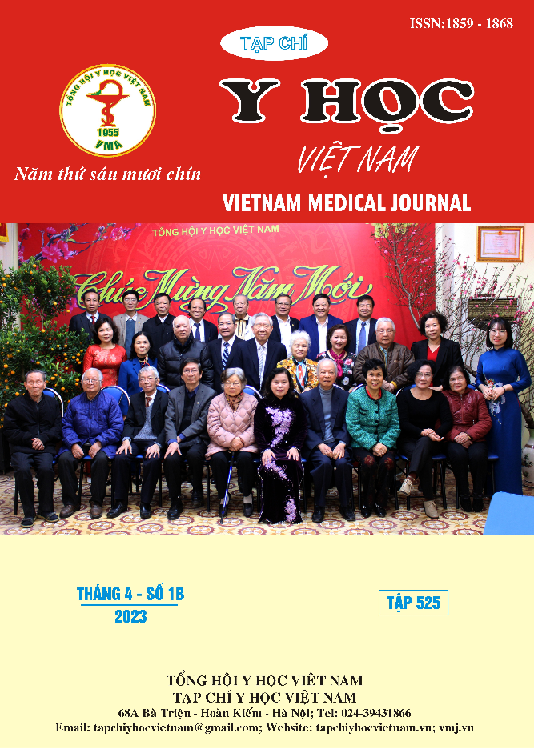CARCINÔM TUYẾN ĐẠI TRÀNG KÈM U TÚI NOÃN HOÀNG: BÁO CÁO MỘT TRƯỜNG HỢP HIẾM GẶP VÀ HỒI CỨU Y VĂN
Nội dung chính của bài viết
Tóm tắt
Các trường hợp carcinôm tuyến đại tràng kèm theo u túi noãn hoàng rất hiếm gặp. Chỉ vài trường hợp đã được báo cáo trong y văn. Chúng tôi báo cáo một trường hợp bệnh nhân nam, 29 tuổi, không có triệu chứng lâm sàng, tình cờ phát hiện u mạc treo. Kết quả chụp cắt lớp vi tính bụng có cản quang cho thấy mạc treo đại tràng lên có tổn thương choán chỗ đậm độ mô đặc, kích thước 95x88mm, bờ đa cung, mất ranh giới với đại tràng lên; đại tràng lên cạnh bên có vị trí mất cấu trúc lớp, hình ảnh học gợi ý chẩn đoán u mạc treo đại tràng hoặc u đại tràng di căn hạch. Nội soi đại tràng ngang ghi nhận khối u dạng thâm nhiễm cứng làm hẹp lòng đại tràng, nghi K đại tràng ngang. Các xét nghiệm huyết thanh AST, ALT, GGT, CEA và CA 19-9 của bệnh nhân trong giới hạn bình thường tuy nhiên AFP huyết thanh tăng cao (42345 ng/ml). Bệnh nhân được phẫu thuật cắt u sau phúc mạc và u đại tràng phải. Đại thể ghi nhận có khối u ở niêm mạc đại tràng và mạc treo. Chẩn đoán giải phẫu bệnh sau nhuộm hóa mô miễn dịch: Carcinôm tuyến đại tràng biệt hóa vừa kèm u túi noãn hoàng xâm nhập qua lớp cơ đến mô mỡ quanh đại tràng.
Chi tiết bài viết
Từ khóa
Carcinôm tuyến đại tràng, u túi noãn hoàng, AFP
Tài liệu tham khảo
2. Elkhaldi M, Naser AM, AlHalaseh Y, Al-Hussaini M. Extragonadal germ cell tumor, a report of two cases presenting in the gastrointestinal tract. Rare Tumors. 2021;13:20363613211029487. doi:10.1177/20363613211029487
3. Kucukoner M, Inal A, Kaplan MA, et al. Germ Cell Tumor Located in Gastrointestinal System: A Report of Two Cases. World J Oncol. Jun 2012;3(3):134-137. doi:10.4021/wjon493w
4. Ronchi A, Cozzolino I, Montella M, et al. Extragonadal germ cell tumors: Not just a matter of location. A review about clinical, molecular and pathological features. Cancer Med. Nov 2019;8(16):6832-6840. doi:10.1002/cam4.2195
5. Otani T, Kanemura H, Kimura M, et al. Yolk Sac Tumor in a Recurrence of Colonic Adenocarcinoma With Shared Mutations in APC and TP53 Genes: A Case Report. Int J Surg Pathol. Sep 2022;30(6):646-651. doi:10.1177/10668969211069963
6. Chahoud J, Kohli M. Managing extragonadal germ cell tumors in male adults. AME Medical Journal. 2020;5:8-8. doi:10.21037/amj.2020.01.01
7. Yu Y OT, Okada S. An alpha-fetoprotein-producing carcinoma of the rectum. Acta Pathologica Japonica. 1992;42:684-687.
8. Coleman TA RC, Hamill RL, Dainer P. Rectal adenocarcinoma with germcell differentiation: report of a case. Dis Colon Rectum. 2003;46:1702-1705.
9. Shah JP, Kumar S, Bryant CS, et al. A population-based analysis of 788 cases of yolk sac tumors: A comparison of males and females. Int J Cancer. Dec 1 2008;123(11):2671-5. doi:10.1002/ijc.23792
10. Hernandez BY, Frierson HF, Moskaluk CA, et al. CK20 and CK7 protein expression in colorectal cancer: demonstration of the utility of a population-based tissue microarray. Hum Pathol. Mar 2005;36(3):275-81. doi:10.1016/j.humpath.2005.01.013
11. Bayrak R, Haltas H, Yenidunya S. The value of CDX2 and cytokeratins 7 and 20 expression in differentiating colorectal adenocarcinomas from extraintestinal gastrointestinal adenocarcinomas: cytokeratin 7-/20+ phenotype is more specific than CDX2 antibody. Diagnostic Pathology. 2012/01/23 2012;7(1):9. doi:10.1186/1746-1596-7-9
12. Kawahara M, Takada A, Tachibana A, et al. Germ cell tumor of the colon with an adenocarcinomatous component. Int J Clin Oncol. Dec 2009;14(6):537-40. doi:10.1007/s10147-009-0880-9


